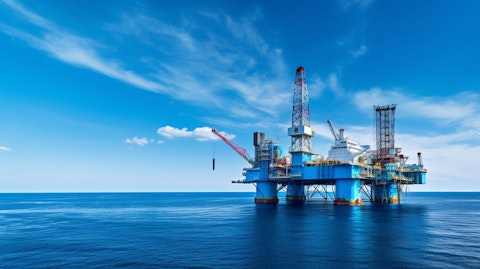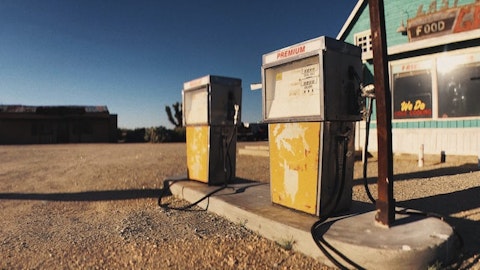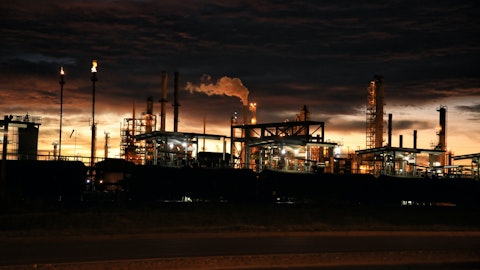Helmerich & Payne, Inc. (NYSE:HP) Q4 2023 Earnings Call Transcript November 9, 2023
Operator: Good day everyone and welcome to the Helmerich & Payne Fiscal Fourth Quarter Earnings Call. [Operator Instructions] It is now my pleasure to turn today’s conference over to the Vice President of Investor Relations, Dave Wilson. Please go ahead.
Dave Wilson: Thank you, David and welcome everyone to Helmerich & Payne’s conference call and webcast for the fourth quarter and fiscal year ended 2023. With us today are John Lindsay, President and CEO and Mark Smith, Senior Vice President and CFO. Both John and Mark will be sharing some comments with us after which we’ll open the call for questions. Before we begin our prepared remarks, I’ll remind everyone that this call will include forward-looking statements as defined under the securities laws. Such statements are based on current information and management’s expectations as of this date and are not guarantees of future performance. Forward-looking statements involve certain risks, uncertainties and assumptions that are difficult to predict.
As such, our actual outcomes and results could differ materially. You can learn more about these risks in our annual report on Form 10-K, our quarterly reports on 10-Q and our other SEC filings. You should not place undue reliance on forward-looking statements and we undertake no obligation to publicly update these forward-looking statements. We also make reference to certain non-GAAP financial measures such as segment operating income, direct margin and other operating statistics. You’ll find the GAAP reconciliation comments and calculations in yesterday’s press release. With that said, I’ll turn the call over to John Lindsay.
John Lindsay: Thank you, Dave. Good morning everyone. Thank you for joining us today. Our fiscal 2023 did not unfold as originally planned, but I want to underscore three noteworthy items that standout in my mind as being pivotal for the company going forward. First, we continue to demonstrate that we are approaching the business differently with a heightened focus on contract economics versus market share. This was evident in fiscal 2022 when the rig count was increasing. In fiscal 2023, the challenges were different as the rig count was only declined much of the year. Yet we still maintained our economic focus and did not revert back to the historical habits of cutting price to maintain market share. Second was the ability of the company to quickly pivot and adapt to a more challenging market while still achieving much of what we set out to do.
We generated healthy margins and a reasonable rate of return for stakeholders. Lastly, we returned approximately 10% of our market capitalization to shareholders through base and supplemental dividends and share repurchases, all of this while maintaining a strong balance sheet. Turning to the details of fiscal 2023, rig demand was negatively impacted by geopolitical and economic uncertainties that influenced the global oil market, as well as warmer than expected winter weather which suppressed pricing in the U.S. natural gas market. Again, we quickly adapted to the market conditions and maintained focus on achieving economic returns above our cost of capital with evidence of coming to traditional focus on market share. Despite the adversity, H&P delivered differentiated commercial value to its customers in return for compelling contract economics.
Even though the industry super-spec rig count declined during much of 2023, we expect activity will increase in 2024 but at levels below the highs seen last year. Those incremental super-spec rigs adds will most likely tighten effective super-spec market utilization well above the 80% level, which historically has been favorable for us from a pricing perspective. Direct margins per day held up relatively well during the fourth fiscal quarter despite the industry decline in rig activity. Notwithstanding the drag created by the sidelining of higher priced spot market rigs during the past couple of quarters, we were able to maintain and slightly improve our revenue per day during the quarter. Nevertheless our expense per day did trend higher and we will comment on that further.
Looking ahead to the next quarter, our guidance suggests our margins will be flat to up slightly. Our ability to drive consistent and reliable value for customers through operations and technology solutions ultimately determines market share over the long term. The adoption of performance-based contracts increased to 52% in the fourth quarter from 41% a year ago. These contracts deploy H&P’s suite of technology solutions that help to drive strong performance and greater reliability. Drilling services make up only a small portion of the overall cost of a well, but rig performance can have an outsized influence on the ultimate economics of the project. Identifying, measuring and then consistently delivering solutions and technologies to improve efficiency and drilling outcomes creates a win-win for both H&P and our customers, improving the financial returns for both as well.
An important element within our contract economics are the operational costs involved in providing our services. Over the past two years, we have experienced increases in operational expenses due to rising labor costs and consumable inventory consumption and cost inflation. A less visible but growing variable is the cost acceleration in equipment related to running H&P’s FlexRig fleet harder than ever before to achieve the well designs, lateral lengths and the drilling efficiencies for our customers. We’ve seen the inflation related to labor and consumable inventory items decrease somewhat in 2023. However, it is being offset by the service intensity required to maintain rigs and equipment at standards that will continue to drive performance and efficiency gains.
Let me provide an example. In the last 10 years, average lateral length has doubled to over 10,000 feet, and at the same time, the well cycle times have improved by 22%. This means that each FlexRig today drills about 4.5 more wells on average per year and those rigs have doubled the exposure to the resource. In 2023, the fleet actually drilled 15 million more feet of wellbore working 33 fewer rigs than a decade ago. This is an example of service intensity and a significant cause of increasing costs related to higher operational costs required to deliver consistency, efficiency and the increased volume of work each rig is now expected to produce. To put a finer point on the magnitude of these cost increases and the impact on our contract economics, North America Solutions operating costs have increased over 50% since 2014.
Like most businesses, we are also experiencing inflationary pressures in our non-operational expenses, particularly around labor and third-party services which are key drivers behind our projected increase in selling, general and administrative expenses. Mark will give more details on this in his remarks. We have begun to capitalize on unconventional opportunities outside the U.S., enabling us to further diversify our operations over the long term. I’m pleased with the early signs of success here, particularly with our recent tender award with Saudi Aramco and the operations of our first super-spec rig in the Beetaloo Basin in Australia. In fiscal 2024, we plan to build on this momentum and continue to deploy capital for future international growth opportunities.
We’re also thankful for celebrating 50 years in Colombia, 25 years in Argentina and the consistent contribution from our Offshore Gulf of Mexico operation and we’re excited about the potential contribution from these segments in the years to come. Shifting to our efforts focused on the energy transition, we are furthering our strategy of deploying capital and expertise to companies advancing innovative approaches to energy. As an example, our investments in geothermal are helping to develop an alternative carbon-free 24/7 power source. We’re providing unconventional drilling learnings and FlexRig technology solutions to enhance and enable next generation geothermal contracts. A recent highlight is the encouraging progress in the field with one of our geothermal investees, Fervo Energy.
We’re currently drilling the fifth well of a multi-year drilling campaign in Utah. This is their first geothermal development project, which will include constructing the second largest geothermal plant in the U.S. and with plans of producing 400 megawatts of geothermal power by 2028. H&P’s super-spec FlexRig-3 along with our technology suite has surpassed our customers anticipated performance targets. Our strategic alliances with Fervo and our other innovative companies have put us firmly on the path to participate in next-generation geothermal opportunities and grow our unconventional geothermal drilling expertise to a larger scale. In addition to our operational and growth accomplishments during the year, we believe an essential ingredient in achieving shareholder success is having a multi-pronged approach to capital allocation.
First and foremost, we prioritize the Company’s longstanding posture of a strong financial position and fiscal prudence. Second, we look to invest in organic projects with attractive returns so that we can continue to lead the industry in the U.S. and develop future growth internationally. Finally, we seek to return capital to shareholders. We have an established base dividend augmented by supplemental dividends and share repurchases when those opportunities exist. Mark will provide additional details about the plan in his remarks. I’m proud of the H&P’s team service attitude and strategic achievements this fiscal year and we’ll remain vigilant as we navigate through 2024. We enter this new year with a sense of optimism around the U.S. market and international opportunities, as well as what we can deliver to both customers and shareholders.
We believe the outlook over the next several years is encouraging for our industry. The long-term energy fundamentals are strong and as such H&P remains ready and we’ll continue to take actions to ensure future success for the company. And with that I’ll turn the call over to Mark.
Mark Smith: Thanks, John. Today, I will review our fiscal fourth quarter and full year 2023 operating results, provide guidance for the first quarter and full fiscal year 2024 as appropriate and comment on our financial position. Let me start with highlights for the recently completed fourth quarter and fiscal year ended September 30th, 2023. The company generated quarterly revenues of $660 million versus $724 million in the previous quarter. The decrease in revenue was primarily due to the expected reduction in active rig count for the North America Solutions fleet. Correspondingly, total direct operating costs incurred were $410 million for the fourth quarter versus $430 million for the previous quarter. The sequential decrease was driven by the aforementioned reduction in activity.

But this decline was somewhat muted by lower-fixed cost absorption and maintenance and supply expense intensity, which ended up being on the higher end of the range this quarter. General and administrative expenses totaled $56 million for the fourth quarter and $207 million for fiscal 2023, which is generally in line with our expectations. The fiscal ’23 effective tax rate was approximately 27%, which is within the previously guided range. To summarize fourth quarter’s results, H&P earned a profit of $0.77 per diluted share versus $0.93 in the previous quarter. Earnings per share were positively impacted by a net $0.08 gain per share of select items, which was primarily made up of gains on investment securities and settlements of outstanding claims, partially offset by a blue chip swap transaction.
Absent these select items, adjusted diluted earnings per share was $0.69 in the fourth fiscal quarter compared with an adjusted $1.09 during the third fiscal quarter. Capital expenditures for the fourth quarter were $114 million, with full fiscal 2023 totaling $395 million, which was generally in line with our expectations from the July earnings call. H&P generated $215 million in operating cash flow in the fourth quarter and a total of $834 million during the full fiscal 2023. Our cash flow generation funded $846 million in capital deployment, including $395 million of CapEx, $104 million in base dividends and $98 million in supplemental dividends and $249 million in share repurchases together with related excise taxes. We will discuss our expected accretive fiscal ’24 cash generation and cash position later in these remarks.
Turning to our three segments, beginning with the North America Solutions segment, we averaged 149 contracted rigs during the fourth quarter, down from an average of 166 rigs in fiscal Q3. We exited the fourth quarter with 147 contracted rigs, which was at the high end of our expectation. Note that the 147 rigs corresponds to approximately 80% utilization of the super-spec rigs that have worked within the last year. Revenues were sequentially lower by $66 million due to the expected sequential decrease in the number of working rigs. Segment direct margin was $239 million, within our July guidance range. Total segment per day expenses, excluding reimbursables, increased to $19,800 during the fourth quarter from $18,700 per day in the third quarter.
As discussed in our press release, this was above our expectations due in part to maintenance and supplies expense from rigs running harder. Further cost drivers include rig churn and decrease in labor and overhead absorption. During this trough period, we retained crew personnel and regional specialty positions and rig fabrication and maintenance facility staff, resulting in a lower scale absorption during the quarter. Additionally, the segment incurred a $150 per day related charge related to the change in the fair value of a contingent liability related to an acquisition earn-out based on operating performance metrics. Looking ahead to the first quarter of fiscal 2024 for North America Solutions, as of today’s call, we have 147 contracted rigs.
The contractual churn has been higher than expected, which has kept our activity level relatively flat thus far in the quarter. That said, we expect to end our first fiscal quarter with between 150 and 156 rigs working and are anticipating some additional adds in fiscal Q2. Our current revenue backlog from our North America Solutions fleet is roughly $1.1 billion for rigs under term contract, up from $900 million in the previous quarter. As of today, approximately 60% of the U.S. active fleet is on a term contract. As activity increases, we expect our average pricing levels to remain steady given that spot pricing levels have remained relatively stable and above lower-rate legacy term contracts that continue to roll into the current pricing environment.
In the North America Solutions segment, we expect direct margins in fiscal Q1 to range between $235 million to $255 million. Given that 70% to 75% of our daily costs are labor-related, it is typical to see seasonal declines from payroll taxes, et cetera. In general, our operating costs have increased approximately 25% since the end of fiscal 2019 and are anticipated to continue near current levels due to several factors, including the aforementioned materials and supplies inventory consumption as a result of longer laterals, labor expenses elevated by two inflation adjustments in the past two years and supply chain cost inflation. Further, continued rig churn drives cost levels higher. These increased costs are one of the many reasons we are acutely focused on maintaining recently achieved pricing levels as we strive to earn appropriate returns on our investments.
Regarding our International Solutions segment, we had approximately 13 rigs active at September 30 as expected and sequentially flat from prior quarter. As a reminder, we revised international guidance via our October 18 press release as a result of accelerating some rig commissioning due to timing efficiencies at our Houston facility and due to certain ex-pat labor expenses. Further, we experienced a 4.6 million foreign exchange loss on Argentina pesos in country based on the devaluation of the official exchange rate in this segment, which is in the segment results. Separately, we experienced a $12 million investment loss related to accessing the blue chip swap effective parallel exchange mechanism in Argentina. Although we took this investment loss, we were able to repatriate that $9.8 million to the U.S. which otherwise would not have been available.
Looking towards the first quarter of fiscal 2024 for the International segment, we expect to idle one rig in Argentina mid-quarter, with all other countries remaining at constant activity levels. Aside from any foreign exchange impacts, we expect to have between $7 million to $10 million in direct operating contribution – direct margin contribution in the first quarter. Turning to our Offshore Gulf of Mexico segment, as expected, we completed the demobilization of a rig in the fourth fiscal quarter and now have three of our seven offshore platform rigs contracted. We have management contracts on three customer-owned rigs, one of which is on active rate. Offshore generated a direct margin approximately $7 million during the quarter, which was within our guided range.
As we look towards the first quarter of fiscal 2024 for the Offshore Gulf of Mexico segment, we expect that it will generate between $3 million to $7 million in direct margin, which is down sequentially primarily due to the stacking of the aforementioned rig. Now let me look forward to the first fiscal quarter and full fiscal year 2024 for certain consolidated and corporate items. Let me start by reiterating features in our multi-pronged approach to capital allocation that John mentioned earlier. Our strategy is to maintain our strong balance sheet together with investment-grade credit metrics, to invest in maintaining our market leading North America Solutions fleet and to deploy capital to support growth and diversification opportunities internationally with prudent investments in our rig fleet.
Finally, our recently announced 2024 supplemental shareholder plan, returns land, continues our strategy introduced a year ago to flexibly augment value to shareholders. As discussed in our October ’18 press release and in yesterday’s release, our fiscal 2024 CapEx has three buckets, North America, International and Corporate and information technology. Our bucket of North America Solutions includes maintenance CapEx costs, which are anticipated to push above the high end of the fiscal 2023 range due in part to fiscal year 2023 supply chain delays in capital spending for component equipment refurbishment and recertification that has rolled into fiscal year 2024. Fiscal ’24 maintenance CapEx per active rig should approximate $1.3 million to $1.5 million per active rig based on current bottoms-up maintenance facility and supply chain throughput expectations.
This level of capital intensity has some inflation built in from the last couple of years, but it also – it is also at a projected high point due to continued catch-up spending from the 2020 downturn. The international bucket primarily consists – excuse me, international bucket partially consists of a planned minor upgrade of three rigs in Argentina utilizing funds currently in-country to take them to full super-spec capacity. We plan to continue converting slightly over one rig per month to walking capability at our Houston facility, resulting in approximately 14 conversions in fiscal ’24. These conversions will be split between North America Solutions and international exports, depending on the successful outcomes of current and anticipated international bids and on the U.S. customer demand at attractive rates and terms.
The final bucket of corporate and information technology consists primarily of enterprise, financial and operating system upgrades and rig communications improvements. Depreciation for fiscal 2024 is expected to be approximately $390 million. Our sales, general and administrative expenses for the full fiscal 2004 year are expected to be approximately $230 million, which is up from the prior year. We have continued to build capabilities to support the Company, including expertise that has aligned pricing with the value delivered in North America and in securing initial Middle East international growth. We have also introduced several software-as-a-service solutions to improve our data and analysis in many areas. And finally, we have experienced inflation across many functional areas in 2023 for labor and third-party services, for which we will bear the full run rate in fiscal 2024.
Our investment in research and development remains largely focused on solutions for our customers, such as drilling automation, wellbore quality and power management. We anticipate R&D expenditures to be approximately $30 million in 2024. We are expecting an effective income tax rate range of 24% to 29%, with the variance above the U.S. stat rate of 21% driven by state and foreign taxes. Based upon an estimated fiscal ’24 operating results and CapEx, we are projecting a consolidated cash tax rate range of $150 to $200 million. Now looking at our financial position, Helmerich & Payne had cash and short-term investments of approximately $350 million at September 30, 2023 versus $293 million at June 30. Including the availability under our revolving credit facility, our liquidity remains at approximately $1.1 billion.
As announced in their October press release, subject to ongoing board approval, we plan to pay supplemental dividends across fiscal 2024 of about $68 million, which is approximately 50% of the projected remaining cash flow after CapEx and after our established base dividend. In essence, over two-thirds of cash flow after CapEx is planned to be returned to shareholders, with approximately one-third remaining for flexibility. As of today, this flexible $68 million unallocated, together with our current $350 million in cash and short-term equivalents on hand, provides us with much flexibility for accretive investments, opportunistic share buybacks and/or further supplemental dividends. Future capital allocation plans look to further add to our long-standing priority of returning cash to shareholders, increasing the roughly $3.1 billion of cash that we have returned to shareholders during the past 10 years through dividends and share repurchases.
That concludes our prepared comments for the fourth fiscal quarter. Let me now turn the call over to David Creed for questions.
See also 13 Best DRIP Stocks To Own and 12 Dogs of the Dow Dividend Stocks to Buy.
Q&A Session
Follow Helmerich & Payne Inc. (NYSE:HP)
Follow Helmerich & Payne Inc. (NYSE:HP)
Operator: [Operator Instructions] We will take our first question from David Smith with Pickering Energy Partners. Please go ahead. Your line is open.
David Smith: Hi, good morning. If you can indulge me for just a second —
John Lindsay: David. We can barely hear you. If you can speak up a bit.
David Smith: Okay. Is this any better?
John Lindsay: Yes, that’s much better, David. Thank you.
David Smith: Okay, sorry about that. If you could indulge me for just a second so I can properly frame the question. I wanted to acknowledge the impressive leadership and success on the pricing discipline, the strong shareholder returns generated. Not many companies returning almost 50% of EBITDA to shareholders in ’23. But then I look at the international CapEx program, which I think was around $100 million to $110 million in fiscal ’23. I think it looks closer to $150 million, $160 million for fiscal ’24. I see a segment that generated $25 million of direct margin this last fiscal year. And just wanted to ask if you can kind of remind us what the investment is targeting in terms of what kind of activity levels you’re ultimately targeting, the timing to get there. Any other you might want to bring to the international growth aspirations?
John Lindsay: Thank you, David. That’s, that’s a great question. I did want to mention that we do have a lot of aspirational growth internationally. I also wanted to be clear that there are multiple tender bids that are going on, multiple countries really. And so at this stage of the game, we’re really not in a position where we want to give out a lot of information related to that as far as just the details, just for competitive advantages – competitive reasons. I think in the next couple of months, we’ll be able to get quite a bit more color on that. But suffice it to say, our intention is to continue to invest in the FlexRig fleet that’s here in the U.S. and look to export that capacity international.
Mark Smith: I might just add a couple of footnotes Dave. Over the long term, obviously, our goal is to grow the percentage of the corporation’s consolidated EBITDA in international by exporting some of these rigs that are suited for unconventional emerging markets overseas. But we’re not giving any specifics related to those targets. It’s a long process and we had a couple of key wins that John mentioned in the prepared remarks, Saudi Arabia and Australia that will happen this year, but we’re trying to do these investments, obviously generating returns, like a double-digit ROIC that we achieved in fiscal 2003 through time. And as John said, we want to be, for competitive reasons, we don’t want to talk a lot about specifics with these.
Suffice it to say, that we have some ongoing current bids and some others that we anticipate coming down the pipeline and in the near term we can put some rigs to work in the U.S. for short-term contracts having these available for longer-term export opportunities. I’m confident that we will generate returns on the investments made.
David Smith: Great. I appreciate all the color and look forward to the announcements when you’re able to make them. If I could sneak a quick follow-up in there, and sorry if I missed this. But just thinking about the fiscal Q1 guidance for North America Solutions with margins. I think the implied daily margin flat to slightly up. I was just wondering if you could share your view on how the daily OpEx is impacting the Q1 guidance?
Mark Smith: Yes, David, I appreciate the question. Costs were higher as we mentioned in the fiscal fourth quarter. And I would just put it into three buckets really for simplification. I think we’re over 1,000 to 1,100 versus a lot of analyst estimates. And I would say call it 300 of that was related to labor absorptions. So with increasing rigs, that will come down. Another 200 or so related to the higher materials and supplies consumption and intensity, which appears to be with us for a bit. But the balance – the rest, really, are a hodgepodge of other items that should not reoccur.
David Smith: Okay, great color, I appreciate that. I will turn it back.
John Lindsay: David. Thank you.
Operator: We’ll take our next question from Kurt Hallead with Benchmark. Please go ahead. Your line is open.
Kurt Hallead: Hi, good morning.
John Lindsay: Morning, Kurt.
Kurt Hallead: I appreciate the color and the commentary. So I’m kind of curious, right, as to the – you mentioned expectation for improved activity out into 2024 and those levels of activity will not quite get back to the highs that were reached in 2023. And then you kind of provided incremental color around 80% plus utilization for super-spec rigs. So just kind of curious as to what you’re hearing from the E&P client base. Until recently, I guess, it’s just kind of bled rigs lower and what – what’s kind of providing the impetus for them maybe to turn things back on going into 2024?
John Lindsay: Well, I think if you look at the activity levels during the course of the year, obviously early on a lot of the activity declines were related directly to natural gas, natural gas pricing. As we’ve gone through the year, what we’ve seen is a lot of a lot of churn associated with a lot of different reasons, but whether it’s budget driven, whether it’s production driven. A lot of this goes, Kurt, goes back to the capital discipline that the industry is showing, E&Ps, our customers are showing, which again I think is healthy for the industry. So in many cases, we’re seeing somewhat of a reset in their capital budgets for the next year, is largely what we’re seeing. I mean I think in general I think consensus has 40 to 60 rigs on average being added for 2024. And I think that’s a reasonable expectation. And if you look at it as it relates to our current market share, I think it really fits in with what we’re describing for our first quarter fiscal Q4.
Kurt Hallead: Okay, I appreciate that. Now maybe follow up is, as you indicated, right, the substantial efficiency gains, FlexRig drills and so on, leading to fewer, I guess, ultimately leading to fewer number of rigs needed by the industry, at least in the U.S. market kind of going forward. So in that context, it seems to me like part of that is playing into your strategy to pursue some of these international opportunities. Am I reading too much into that?



